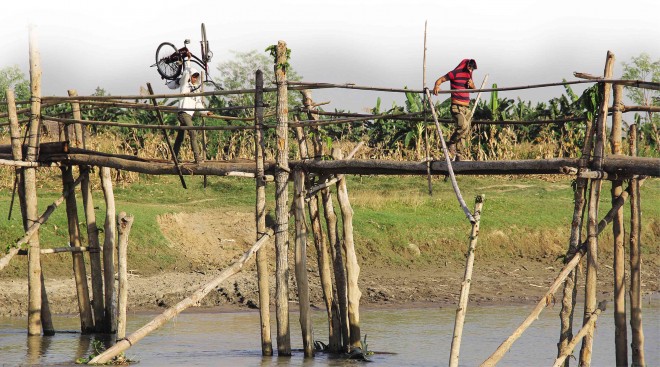Death bridge also symbol of neglect

A MAN carries his bike across the bridge in the village of Tukanalipao in Mamasapano town, Maguindanao province. BARRY OHAYLAN/CONTRIBUTOR
The makeshift wooden bridge in the village of Tukanalipao in Mamasapano, Maguindanao province, has become a symbol not only of years of neglect, but also of the yearning for peace of the people of Mindanao, a legislator said after a four-day, fact-finding mission to the site of a clash between Moro guerrillas and police commandos, who were on a mission to get international terrorist Zulkifli bin Hir, alias “Marwan.”
“It was the bridge that the beleaguered police commandos of the Special Action Force (SAF) failed to cross,” Bayan Muna Rep. Carlos Zarate said. “It was a bridge of no return,” he said.
“Now, that bridge has become a symbol of our situation in Mindanao,” he added.
“Made only of raw, ordinary wood linked and tied on top of each other and hardly even polished, the bridge would have served as a link between the people in this isolated community to the rest of Mindanao, a step to a lasting peace on the island,” Zarate said.
“But now the bridge has become a symbol of the new turmoil that again threatens to blow up,” he said.
Article continues after this advertisementFor the SAF commandos who met their deaths in the cornfields of Mamasapano, the bridge became a symbol of tragedy.
Article continues after this advertisementCrossing it proved impossible at the height of the raging gun battle because doing so would mean the beleaguered SAF commandos would have to do it in a single file, which would turn them into sitting ducks for enemy fire.
The bridge, which stretches 30 to 50 meters long from the opposite banks of the Mamasapano River and sits 5 to 6 m above the water, was also the same bridge where farmer Badrudin Langalan, 18, met his death when he chanced upon the blocking force of the SAF on Jan. 25, when 44 SAF commandos, 18 Moro guerrillas and five civilians were killed in the operation to get Marwan.
Langalan’s body, his hands and feet bound, was found among the bodies of SAF commandos later that day, according to the fact-finding team that entered the area from Feb. 8 to 11.
Bai Ali Indayla, spokesperson of the Moro human rights group Kawagib, said Langalan left his house around 4 a.m. on Jan. 25 to charge his cell phone in the town proper of Tukanalipao when the SAF commandos came.
When the bodies started piling up, Langalan’s body was found among those of the fallen SAF commandos.
Gabriela Rep. Luz Ilagan said the condition of the bridge seemed to show how little the government cared for the people.
“The place is very poor, the people have little to count on, and now they have no future, they are staying with relatives,” Ilagan said, as an estimated 1,500 people in villages surrounding the clash site fled their homes.
Zarate described Tukanalipao, the site of the bloodshed, as one of the places in the country where the soil was so rich, but the people were so poor.
“You can see how rich the soil is by how big the corns grow,” he said. “Yet, Barangay Tukanalipao, which is only 2 kilometers away from the town center, has no barangay hall. We had to talk under a makeshift structure,” Zarate said.
“When you enter the area, you can see the fertile land where the corn grows very big,” Zarate said. “But in the middle of the cornfield lies the Mamasapano tributary, and over it, the bridge of no return, the bridge over the Mamasapano River that the fallen 44 SAF men failed to cross,” he said.
While the 30- to 50-m span of the bridge once spelled life and death for the SAF commandos, it now spells the survival of the fragile peace on the island, as warmongers, who know nothing about what the people of Mindanao have been going through, are crying for blood.
Ilagan said women in Mamasapano had been looking forward to the ongoing peace process to finally put an end to the decades of war they had suffered and so they could finally get on with their lives. On the eve of the encounter, the women were bothered by the sound of drones hovering in the sky, but drew assurances from a peace agreement between the government and the Moro Islamic Liberation Front that they thought had silenced the guns.
“Thinking this was already peace time, they brushed off their doubts and anxieties about a possible military encounter,” Ilagan said.
But on Jan. 25, the women were awakened by sounds of gunfire at dawn and, dragging their children with them, they fled their houses again.
When they returned after noon, they learned about the deaths of their husbands.
Ilagan claimed there were at least seven civilians killed in the encounter, including 8-year-old Sarah Pananggulon, in Sitio Inugog.
Pananggulon was sleeping with her parents and younger brother when armed men, who residents later identified as SAF commandos, started shooting in the direction of their house. Sarah’s parents, Samrah Sampulna and Pananggulon Mamasalaga, were wounded as they tried to flee.
Aside from Pananggulon and Langalan, a report from the Autonomous Region in Muslim Mindanao on civilian casualties included a certain Mursid Masim and Mohammad S. Ambilang.
“While the media coverage mainly focused on the death of 44 police commandos, little has been said about the Moro communities in Mamasapano, Maguindanao,” Indayla said.
“These women are invisible, their voices have not been heard,” Ilagan added. “It’s so easy for people in Manila to call for an all-out war, when they don’t understand our situation. People in Mindanao are tired of evacuations.”
“Bakwet (Evacuation), giyera (war), over and over again. When will it ever end?” she said.